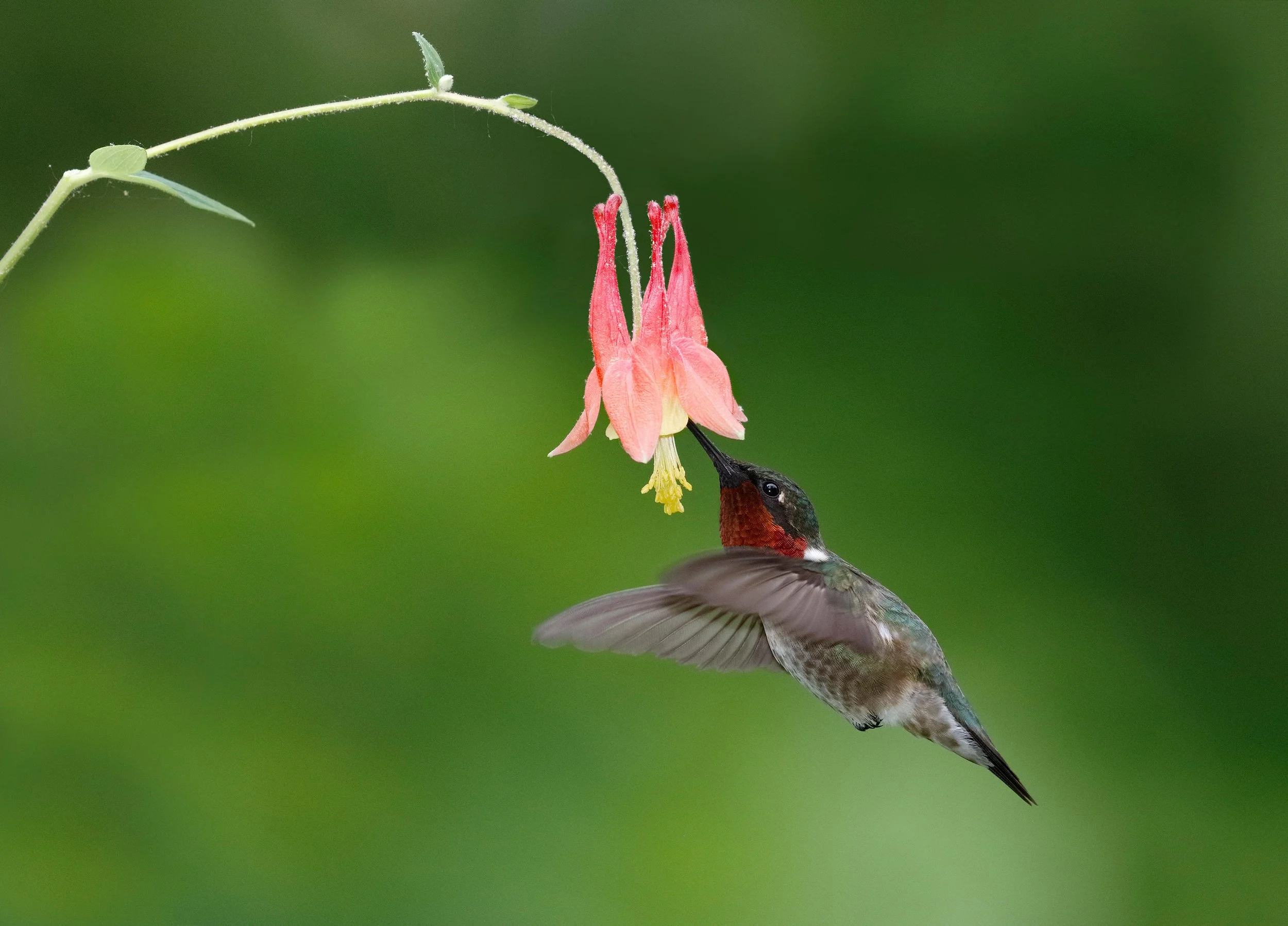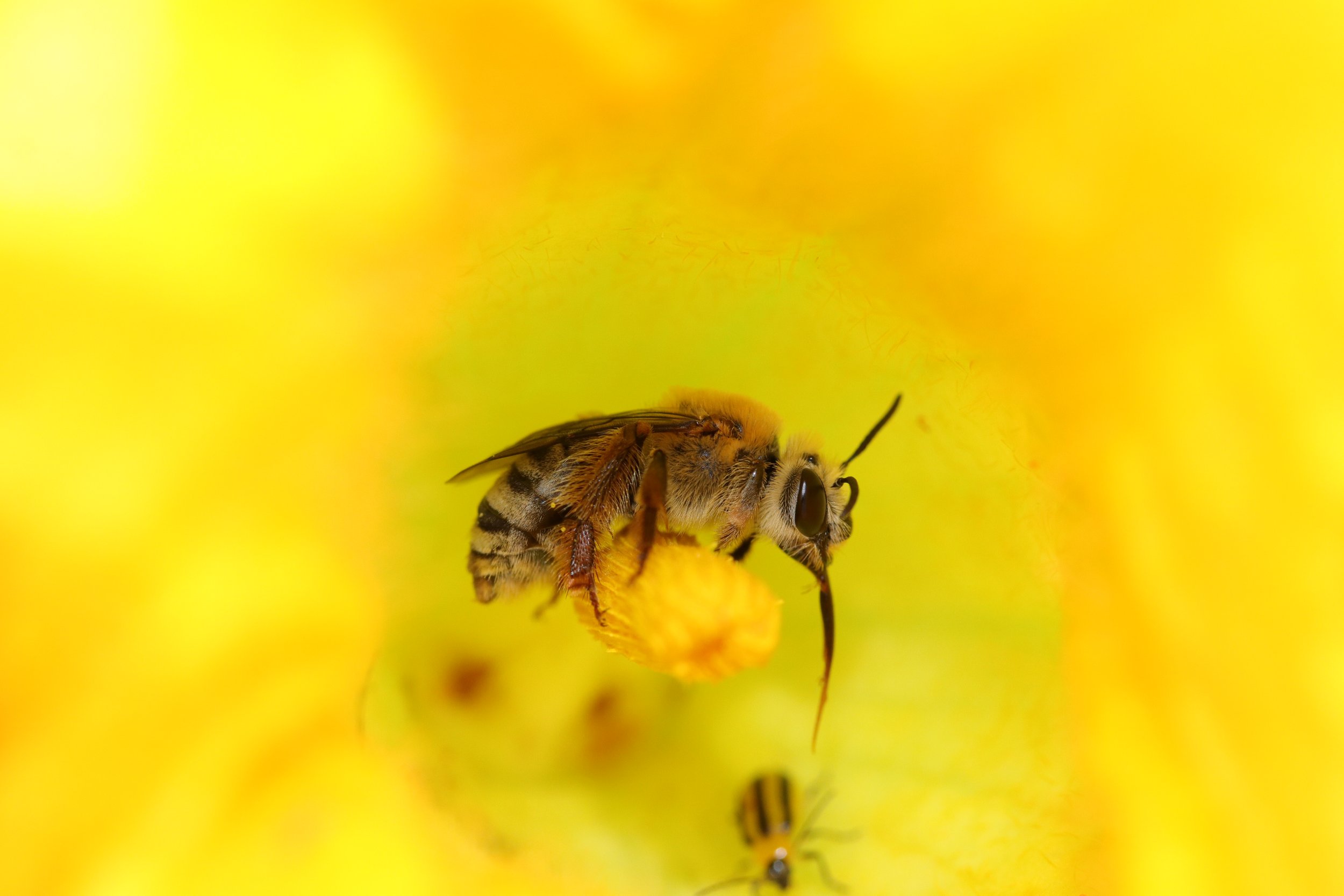Why Native Plants?
Native plants provide more than just flowers. They offer numerous critical supports for insect life, offering habitat, shelter, and nesting materials, in addition to pollen and nectar. Though scientific research is still uncovering details about many of the relationships between plants and insects, we know that the connections between native plants and pollinators constitute a rich and complex tapestry of interconnectedness and interdependence.
The ultimate tool for sustaining native pollinators is cultivating native plants—those plants that have historically grown wild in the Hudson Valley bioregion. Native plants are the partners our native pollinators have evolved alongside for millions of years. Their life cycles are intricately intertwined.
Native plants and pollinators are so closely linked by evolution that they are often physically matched, like puzzle pieces. For instance, the nectar stored within many tube-shaped flowers, such as beardtongues (Penstemon species), can only be accessed by bees, birds, and butterflies equipped with tongues long enough to reach down to the flower’s base. Other native flowers sport nectaries perfectly suited to the short- or medium-tongued anatomy of their animal partners. In another example, vibrations of bumble bees as they perform “buzz pollination” are perfectly calibrated to release pollen from the specific native plants they have evolved to forage.
Most of our Hudson Valley pollinators feed exclusively on native plants, and of those, some have such a limited number of food plants that they are considered “specialists.” Specialists depend on a single plant genus (a group of closely related plants), or even a single species, for survival. Specialist pollinators are surprisingly common, comprising approximately 25% of the roughly 770 bee species native to the Northeast. Since the remaining portion of bees can generally forage on the same plants that specialists require, planting for specialists is a great conservation approach to support a diversity of species.
(photo right) Native plants and pollinators are synced in time. The pollen structures of native squash flowers reach maturity just as squash bees emerge from their underground nests. Squash flowers also open only during the early morning hours, when squash bees are active. Credit: Molly Jacobson
Juniper Hairstreak - Bugwood Caption: Juniper hairstreak caterpillar on its foodplant. Credit: Patricia M. Ciesla, Forest Health Management International, Bugwood.org
While many bees are pollen specialists, other pollinators, usually moths and butterflies, spend their larval stage feeding on plant leaves. These caterpillars can often feed only on a few species of plants, known as their “larval host” plants. Monarch butterfly caterpillars’ limited diet of milkweeds (Asclepias spp.) is the most famous example of this type of specialist relationship, but butterflies’ and moths’ reliance on a narrow range of host plants is a widespread phenomenon. The imperiled appalachian azure butterfly, native to the Hudson Valley, depends entirely on one larval host plant—the woodland wildflower black cohosh (Actaea racemosa)— to complete its life cycle. Black cohosh is one of the many native forest understory plants which are threatened by the pressures of deer browsing and invasive plants such as garlic mustard.
A garden that’s bursting with exotic ornamental flowers might look beautiful, but is of no use to a specialist pollinator such as the mottled duskywing butterfly (Erynnis martialis), which can only lay its eggs on the leaves of the native New Jersey tea plant (Ceanothus americanus). While some research has suggested that including certain flowering non-native plants along with native plantings can boost supplies of pollen and nectar, this is mainly helpful to “generalist” pollinators such as such as the common eastern bumble bee, Bombus impatiens. Generalist pollinators, which forage on a wide variety of plants, are less vulnerable to population decline than specialists. So, while you can include some non-native, non-invasive plants in your pollinator-friendly landscape, planting native plants is the surest way to protect pollinator diversity, supporting the whole range of native pollinators, as well as birds and other wildlife.
(Photo right): Appalachian azure butterfly laying eggs on its host plant. Credit: Mel Kelley · some rights reserved
FOR FURTHER READING
Dig deeper into native plants with these great resources:
BOOKS:
Bringing Nature Home: How You Can Sustain Wildlife with Native Plants (Douglas Tallamy, 2009)
Native Plants of the Northeast: A Guide for Gardening and Conservation (Donald J.Leopold, 2005)
The Northeast Native Plant Primer: 235 Plants for an Earth-Friendly Garden (Uli Lorimer, 2022)
Spring Wildflowers of the Northeast (Carol Gracie, 2020)
Summer Wildflowers of the Northeast (Carol Gracie, 2020)
APPS:
iNaturalist - an excellent, free and globally available tool for plant and wildlife identification, citizen science, and logging observations
Seek: plant identification app hosted by iNaturalist
PictureThis - a great plant identification app for iPhone and Android
ORGANIZATIONS:
Wild Ones (national) and Wild Ones Mid-Hudson Valley (local chapter)
Ripples of Restoration
Planting native benefits the entire ecosystem, creating ripple effects far beyond pollinators. Native plants provide forage and shelter for all native wildlife, from other insects and spiders to amphibians, birds, and mammals. Native trees and shrubs often support hundreds, if not thousands, of wildlife species. Oak trees alone, perhaps the most vital keystone tree species, support approximately 432 moths and caterpillar species in Eastern forests, and up to 4,000 total wildlife species.
Our wild chokecherry, Prunus virginiana, is a larval host to upwards of 300 moths and butterflies, including three at-risk Sphinx months on the target list, and its flowers provide pollen or nectar for a further twenty at-risk pollinator species. When this small native tree’s berries ripen in the fall, they become a favorite food source for over seventy species of birds, as well as a range of mammals, from mice to foxes and bears. Even chokecherry’s twigs can be a winter food source for animals, and the shelter of its branches provides nesting sites and cover for birds and other animals.
Planting native wildflowers, grasses, trees, and shrubs attracts a bevy of insect life, not just pollinators but the other myriad insects that eat these plants, such as native aphids and leafhoppers. The shelter of closely planted native grasses and flowers provides habitat for crickets, grasshoppers, fireflies, and katydids. This bounty of insect life will in turn draw and sustain other wildlife–insectivores of all shapes and sizes, from tiny ambush bugs to green tree frogs, insectivorous birds like belted kingfishers, and small insectivorous snakes. Bird species also depend on the caterpillars these native plants support in order to feed their young—a pair of nesting chickadees require more than 6,000 caterpillars to feed one brood of chicks. In the fall, grass and flower seed heads provide another round of sustenance for birds with protein-rich seeds.
Credit: Steve Smith
The positive impacts of planting native extend even beyond their many wildlife benefits. Native plants can be the most climate-resilient gardening option available, often requiring less water, fertilizer, and pest control than traditional non-native garden plants (especially the most common of all, our ubiquitous and non-native lawn grass!). And even if we can’t predict the exact scale or pace of upcoming climate-related changes in the Hudson Valley, we do know that restoring native plant biodiversity is a key part of building climate resilience in our natural communities.
NATIVE RANGE AND CLIMATE CHANGE
As climate change continues to shift annual weather patterns, we will see changes in plants’ distribution ranges. Notably, our native hardwood maple-beech-birch forests have been shifting northwards as temperatures rise. We may see an influx of new, more southerly plant species in the Hudson Valley as our hardiness zones continue to slip northwards with rising temperatures. However, there are still many unknowns about which plant species will shift and at what pace, and plant “migrations” are likely to be hindered by deer overpopulation, human development, extreme weather and other unknown impacts of a warming climate. We also don’t know how or whether our native pollinators will be able to shift along with them. This guide advocates for planting primarily species historically native to the Hudson Valley as our best hope for pollinator conservation. It also includes a few species from outside our bioregion that are likely to support at-risk pollinators here; these species are noted in the plant list.





